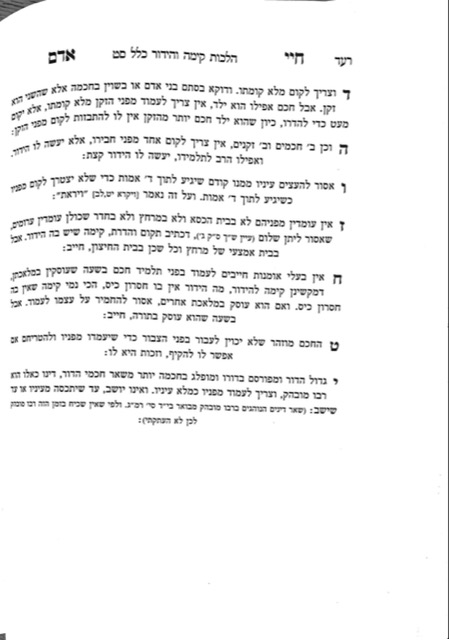We are beginning siman 4, regarding giving kavod to talmidei chachamim. We learned about the situations in which a person is chayav to stand up; today we will learn about the definition of standing up.
The Chayei Adam writes that the basic halacha is that when a person is chayav to stand up, they should stand up to their full height. This applies to an average person standing for a talmid chacham, or for two people of equal knowledge, but the person passing by is a seivah and the person standing up is not a seivah.
However, the Chayei Adam clarifies that a young talmid chacham who is standing up for someone older who is not as knowledgeable as the young talmid chacham does not need to stand up to their full height, but should rather just raise themselves slightly. Part of the young talmid chacham’s chiyuv of kavod hatorah is for him to recognize his own knowledge of Torah, and that, in this situation, he has a greater knowledge of torah than the seivah. If he were to stand to his full height, in a certain sense he would be disgracing his knowledge of Torah. He does not perform kimah, but he is still chayav in hiddur, which he demonstrates by rising slowly.
In siman 5, the Chayei Adam writes that if both individuals are talmidei chachamim, or both are elderly, one does not have to stand up for the other. Nevertheless, they are both still chayav in hiddur, so they would raise themselves slightly for each other.
Similarly, between a rebbe and talmid, the talmid obviously must stand up, and the rebbe does not stand up at all. However, if the talmid is a talmid chacham in their own right, the talmid has a chiyuv to stand up fully, and the rebbe should raise himself slightly.
The question we need to address is that although these appear to be straightforward halachos, we see that many do not seem to fulfill this mitzvah to its proper extent. The Shach gives an explanation which we will discuss in the next shiur, be’ezras Hashem.
Summary
- When one is chayav to stand up, they must perform kimah by standing to their full height.
- In certain cases, there is no chiyuv kimah, only a chiyuv hiddur. A person only needs to raise themselves slightly. These cases are:
- A young talmid chacham standing for a seivah;
- One seviah standing for another seivah;
- One talmid chacham standing for another talmid chacham;
- A rebbe standing for a talmid who is a chacham in his own right.



